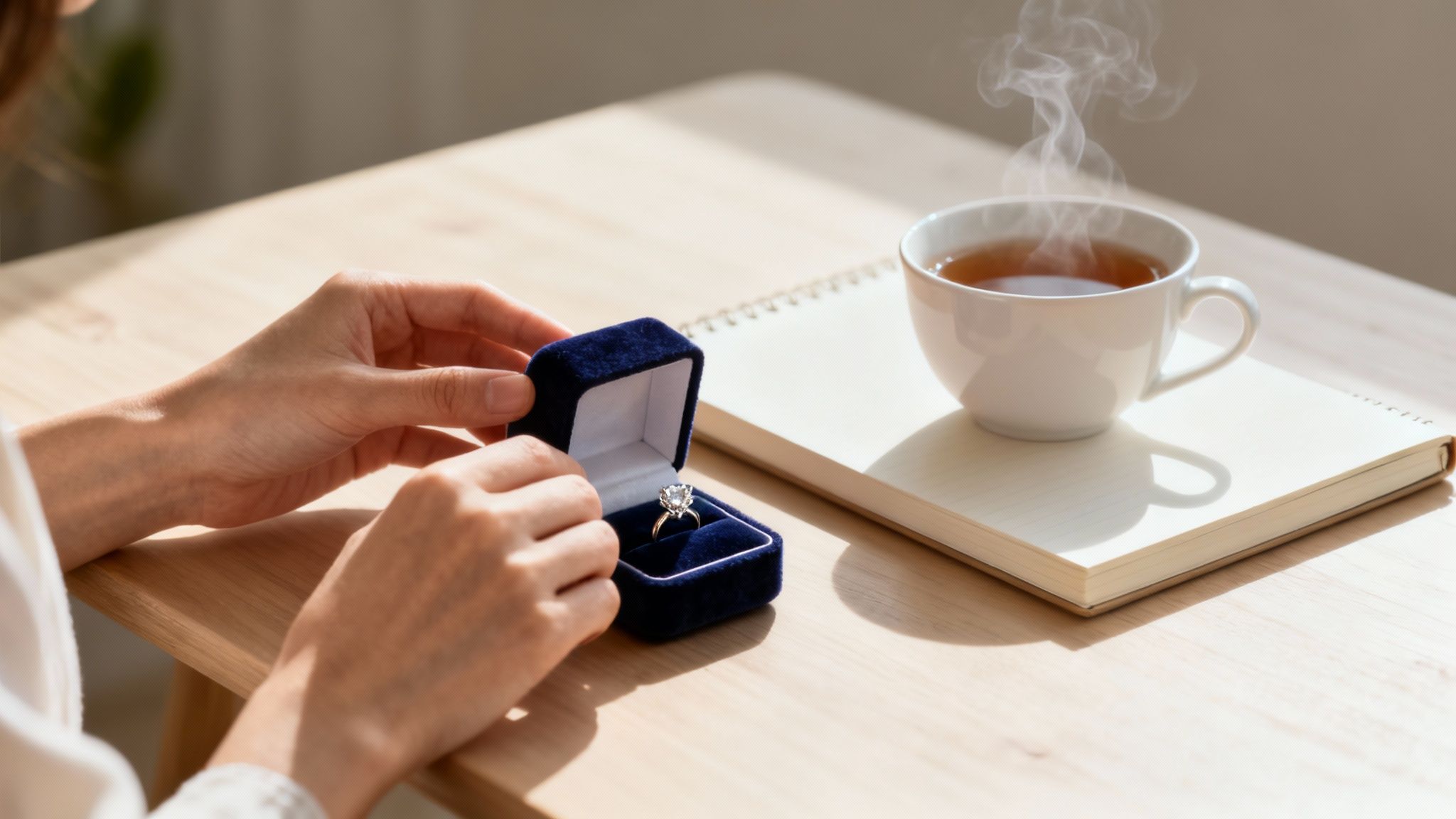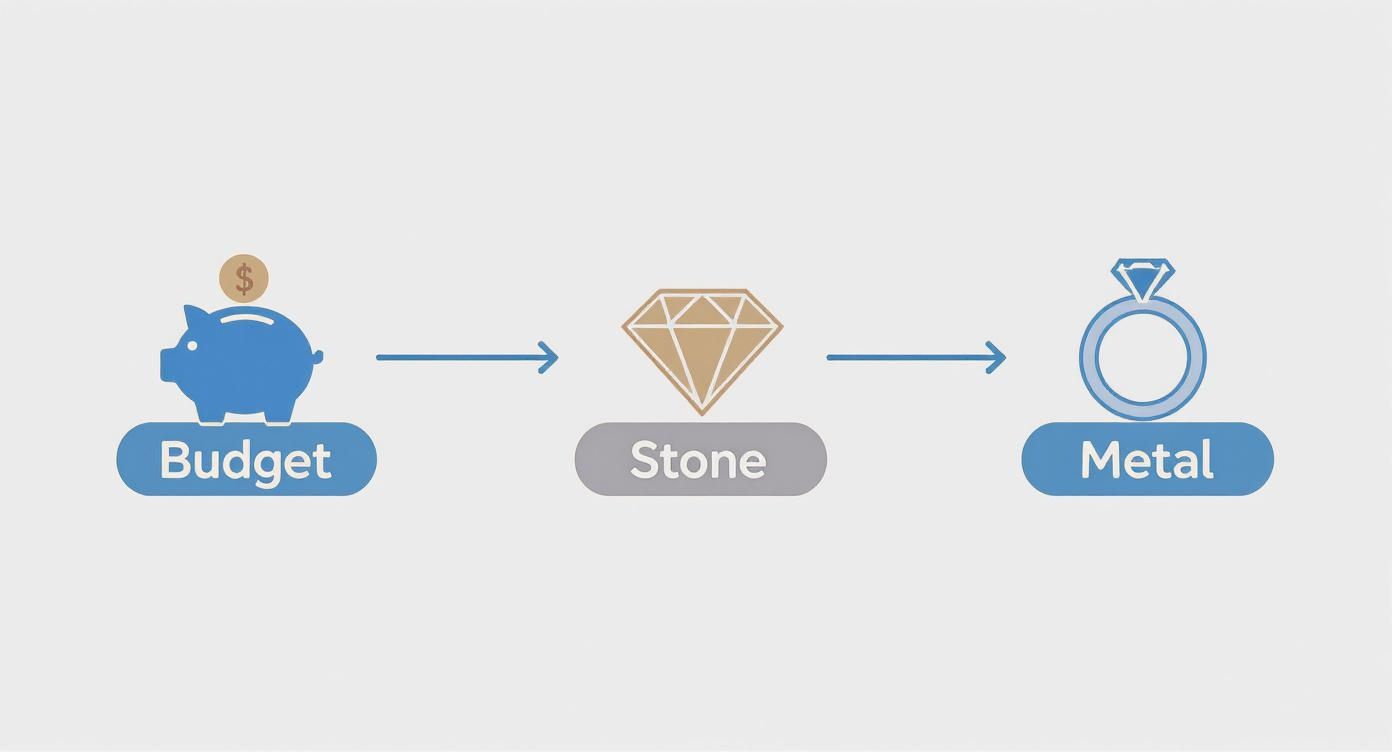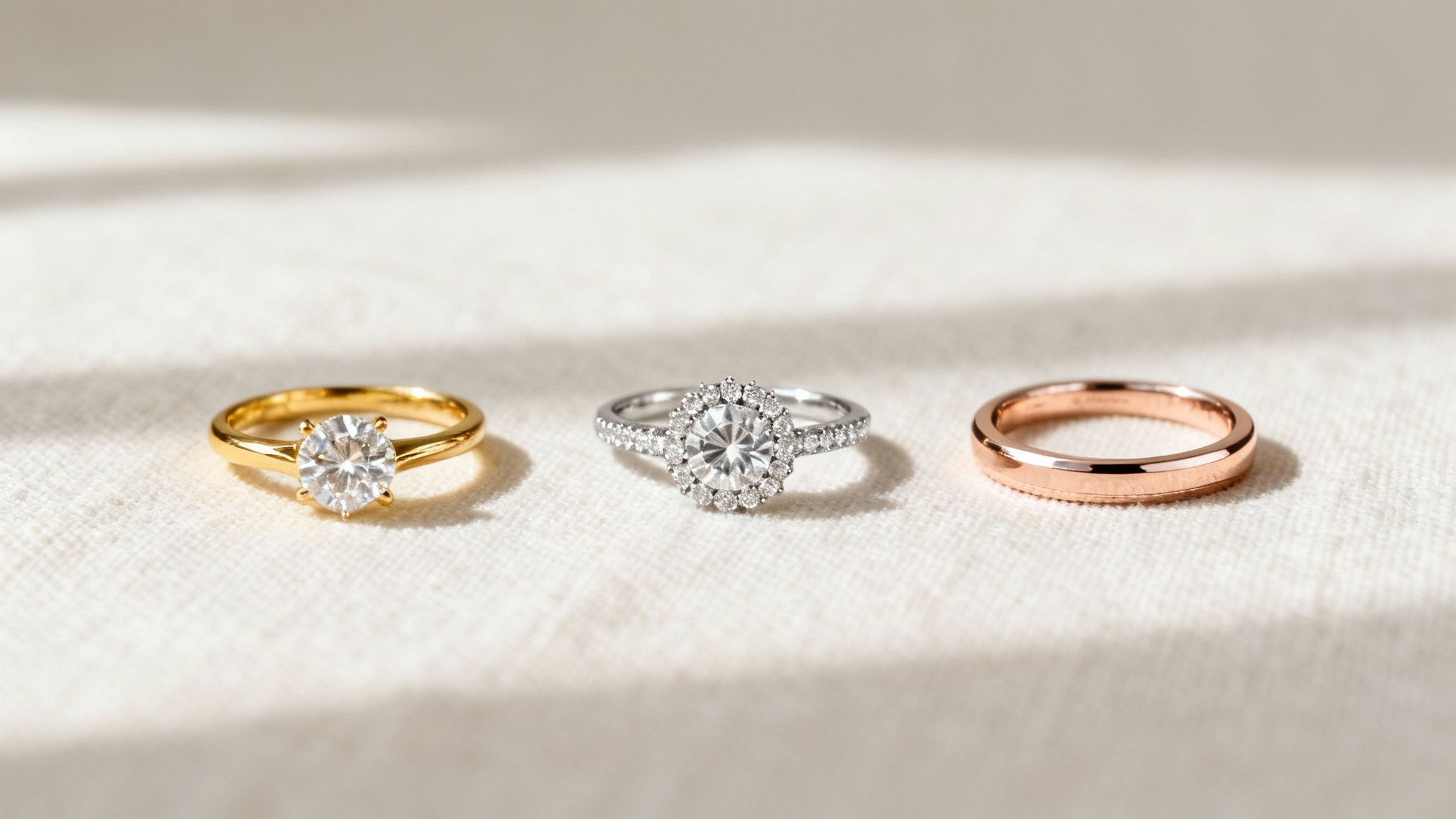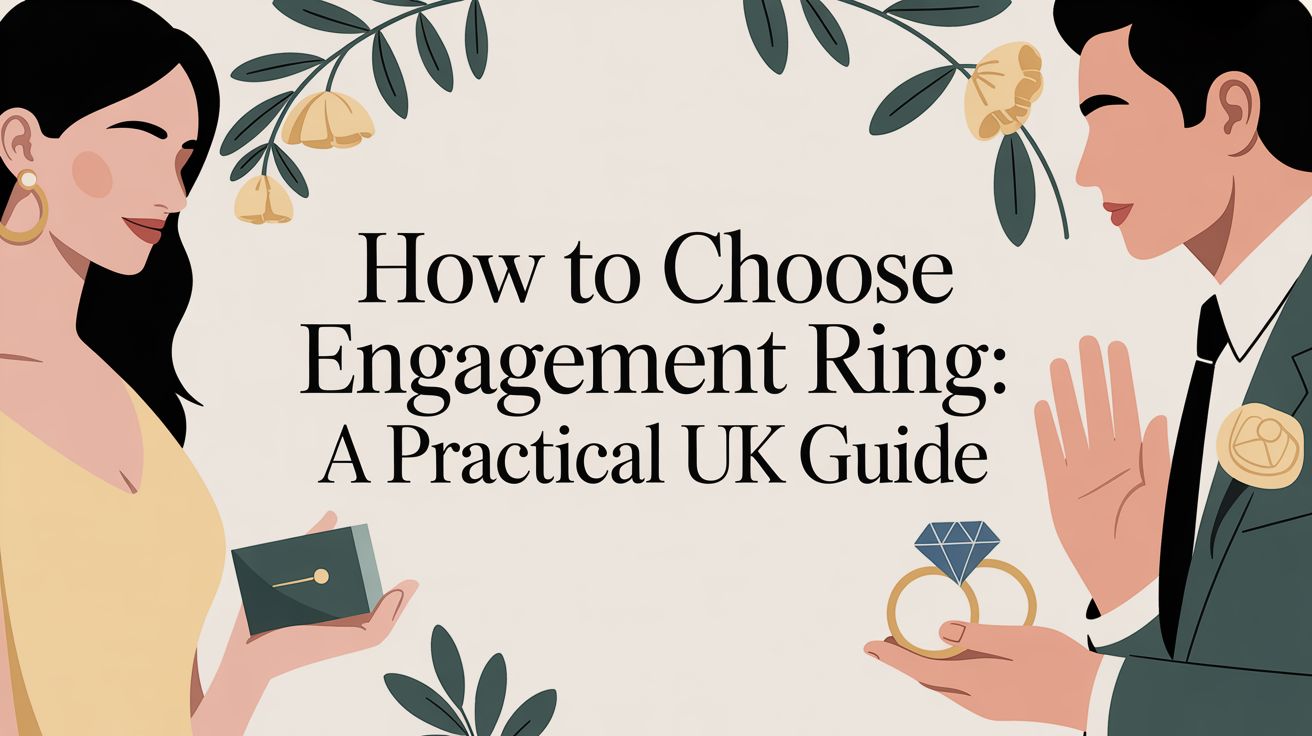Choosing an engagement ring is one of the most exciting purchases you'll ever make. It’s a huge decision, but it shouldn't feel stressful.
At its heart, the process is about finding a beautiful balance between your budget, your partner's personal style, and the quality of the ring itself. This guide cuts through the noise, helping you find a stunning ring that tells your unique story.
Your Journey to the Perfect Engagement Ring

Starting the search is a massive milestone. First thing's first: forget the old myth about spending three months' salary. Your only goal is to find a ring that genuinely reflects your partner and your relationship—a symbol of commitment you'll both adore forever.
Think of this as your practical starting point for navigating the choices ahead with total confidence.
What This Guide Covers
This is about making informed, personal choices, not just ticking boxes. We'll walk you through the most important considerations, making sure you feel empowered from start to finish.
You’ll get a clear, no-nonsense understanding of:
- Setting a smart budget that feels right for you.
- Discovering your partner's style—even if the proposal is a total surprise.
- The 4Cs (Cut, Colour, Clarity, Carat) in simple, practical terms.
- Choosing the right metal to suit their lifestyle and the stone.
- Finding a jeweller you can trust to guide you through the final purchase.
The UK jewellery market is a huge industry, valued at around £4.3 billion in 2024, and rings make up the biggest slice at over 36%. That shows just how many people are on this exact same journey.
Choosing a ring isn't just a transaction; it's an experience. The right piece will feel like an extension of your partner's personality—a timeless classic, a modern statement, or something uniquely bespoke.
Whether you're drawn to classic designs or are thinking about custom engagement ring designs for a truly one-of-a-kind piece, this guide gives you the foundation you need. Let’s get started.
Right, let’s talk money.
Before we get into diamonds and designs, we need to sort out the budget. And please, forget that old wives' tale about spending two or three months' salary. That was a marketing line from a bygone era. Today, it’s all about finding a price point that feels right for you and your financial situation.
The goal here isn't to hit some imaginary target. It's to choose a beautiful ring that symbolises your future together—without starting it off with financial stress. This is about being smart with your money to get the most stunning ring possible for what you’re comfortable spending.
What Are People Actually Spending in the UK?
It helps to have a rough idea of what’s normal. In the UK, the average spend on an engagement ring in 2025 falls somewhere between £1,800 and £3,200. That’s a pretty wide range, and it shows just how much things like the diamond, the design, and the jeweller you choose can influence the final price.
Couples today are far more focused on personal taste and getting real value for their money. We're also seeing a huge shift towards lab-grown diamonds, which can cost over 40% less than a natural diamond of the same size and quality. It’s a game-changer for modern proposals. You can see more details on these UK engagement ring cost trends on WeBuyDiamond.co.uk.
Ultimately, there's no "right" amount. This is just a guide to help you find a budget that lets you get a gorgeous ring without any regrets.
Before we go further, let's break down where the money goes. This table gives you a clear look at what affects the price and how you can be clever about it.
Budgeting for Your Ring: A Practical UK Guide
This table breaks down how different factors influence the final cost of an engagement ring, helping you make informed decisions within your budget.
| Budget Factor | Impact on Price | Money-Saving Tip |
|---|---|---|
| Diamond Carat Weight | High - price increases exponentially, especially at "magic" sizes (1.0ct, 2.0ct). | Go just shy of the full carat. A 0.90ct diamond looks almost identical to a 1.0ct but can be 15-20% cheaper. |
| Diamond Cut Quality | High - The cut dictates the sparkle. An "Excellent" or "Ideal" cut is a non-negotiable for brilliance. | Never compromise on cut. A smaller, well-cut diamond will outshine a larger, poorly cut one every time. It's the best investment for visual impact. |
| Diamond Colour & Clarity | Medium - Higher grades (D-F colour, VVS-IF clarity) are rare and expensive. | Opt for "near-colourless" (G-H) and "eye-clean" (SI1) grades. The tiny differences are invisible to the naked eye but significantly reduce the cost. |
| Natural vs. Lab-Grown Diamond | Very High - Lab-grown diamonds are chemically identical but can be 40-60% less expensive. | Choosing a lab-grown diamond is the single most effective way to get a larger, higher-quality stone for your budget. |
| Ring Metal | Medium - Platinum is the priciest. 18k gold is next, followed by 14k, 9k, and palladium. | 14k gold offers a great balance of durability and colour for a lower price than 18k. Palladium is a fantastic, naturally white alternative to platinum. |
| Setting Style & Complexity | Medium to High - A simple solitaire is most affordable. Intricate pavé, halo, or custom designs add labour and material costs. | A classic solitaire setting puts all the focus (and budget) on the centre stone. You can always add a more elaborate wedding band later. |
This should give you a solid foundation. The smartest budget is one that lets you buy a beautiful ring you’re proud of, without the financial headache.
Smart Ways to Make Your Budget Go Further
Being budget-savvy doesn't mean you have to compromise on the 'wow' factor. It just means you need to be strategic.
Here are a few insider tips that make a massive difference:
- Dodge the 'Magic Numbers': Diamond prices take a huge leap at popular carat weights like 1.0, 1.5, and 2.0 carats. A diamond weighing 0.95 carats looks identical to a 1.0-carat stone to the naked eye, but it could save you a serious amount of cash.
- Embrace Lab-Grown Diamonds: I can't stress this enough. They are physically, chemically, and visually identical to natural diamonds. Opting for a lab-created stone is the biggest lever you can pull to either save a chunk of your budget or get a much bigger and better diamond for the same money.
- Make the Cut Your Priority: Of the 4Cs, the cut is king. It’s what gives a diamond its fire and sparkle. A brilliantly cut diamond can look bigger and more dazzling than a poorly cut stone with a higher carat weight. Always put a good portion of your budget towards the best cut possible.
The best budget allows you to buy a stunning, high-quality ring without adding financial strain. Focus your money on the things you can actually see and admire—like the incredible sparkle from an excellent cut—not on stats that only a jeweller can see under a microscope.
Making Sense of the 4Cs Without Getting Technical
When you first start looking into how to choose an engagement ring, the "4Cs"—Cut, Colour, Clarity, and Carat—can feel a bit like a science exam. But honestly, they're your best tools for finding a stunning diamond that actually fits your budget. Let's forget the complex charts for a moment and translate this into what you can actually see.
Think of it as a balancing act. You don’t need a flawless diamond under a microscope; you need one that looks brilliant on your partner's hand. This is where making smart trade-offs can save you a significant amount of money without sacrificing the beauty of the ring.
This decision tree gives a simple overview of how your budget connects to your choices for the stone and the ring's metal.
The main takeaway here is that every choice influences the next. Prioritising what matters most to you visually is always the smartest approach.
The One C You Should Never Compromise On
If you remember only one thing, let it be this: Cut is king. This has nothing to do with the diamond's shape (like round or oval) and everything to do with how well its facets are angled to catch and reflect light. A poorly cut diamond just looks dull and lifeless, no matter how good its colour or clarity might be.
An "Excellent" or "Very Good" cut grade is non-negotiable in my book. It’s what guarantees the diamond has that incredible sparkle, fire, and brilliance. A well-cut diamond can even appear larger and more vibrant than a heavier stone with a mediocre cut, making it the single most important place to put your money for visual impact.
Finding the Sweet Spot for Colour and Clarity
Now for the areas where you can be clever. Diamond Colour is graded on a scale from D (colourless) to Z (light yellow). But in reality, diamonds in the G-H range are considered 'near-colourless' and look perfectly white to the naked eye. They offer fantastic value.
Similarly, Clarity refers to the tiny, natural imperfections inside a diamond. Unless you plan on examining the ring with a jeweller's loupe, all you really need is for it to be 'eye-clean'. Grades like VS2 (Very Slightly Included) and SI1 (Slightly Included) often have flaws that are impossible to spot without magnification, making them the sweet spot for most people.
Don’t pay a premium for perfection that's invisible. Focusing on an 'eye-clean' diamond in the near-colourless range is one of the smartest ways to make your budget work harder. It lets you invest more in that all-important Cut or even a slightly larger Carat weight.
Carat Weight and Making Smart Trade-Offs
Finally, there's Carat, which is simply a measure of the diamond's weight, not its size. As I mentioned, a better cut can actually make a diamond look bigger. You can also get more for your money by choosing a stone just below a 'magic' number, like a 0.90ct instead of a full 1.0ct. The price drop can be significant, but the size difference is virtually undetectable.
Here are a few practical trade-offs I often recommend:
- Your Setting Matters: A yellow or rose gold setting is very forgiving. It can beautifully complement a diamond with a slightly warmer colour (like a J or K grade), making the stone appear whiter in contrast and saving you money.
- Create a Size Illusion: Elongated shapes like an oval, marquise, or pear cut can look larger than a round diamond of the very same carat weight.
- Consider Gemstones: While diamonds are classic, other durable stones can add a unique and personal touch. For a pop of colour and personality, exploring options like a sapphire engagement ring can be a beautiful and often more affordable alternative.
Finding a Ring That’s Unmistakably Them

With the budget and diamond quality sorted, we get to the really personal part: the style. This is about finding a design that feels like it was made just for your partner.
Even if you’re planning a total surprise, figuring out their taste is easier than you might think. It just calls for a little bit of subtle detective work.
Becoming a Style Sleuth
The clues to their perfect ring are often hiding in plain sight. Start by paying close attention to the jewellery they already wear. Is it delicate and understated, or more bold and modern? Do they always reach for yellow gold, or do they prefer the cool tones of silver or platinum?
Think about their wider aesthetic, too. How do they decorate your home? What's their go-to clothing style? A partner who loves clean, minimalist lines might adore a sleek bezel setting. Someone with a soft spot for all things ornate and vintage could fall for an intricate halo design.
Here are a few more subtle ways to gather intel:
- Window Shopping: Casually walk past a jeweller's window and see what catches their eye. A simple, "That's interesting, what do you think?" can reveal a lot.
- Social Media Scan: Many people use Pinterest to save ideas for the future. A quick, discreet look at their boards could give you the ultimate cheat sheet.
- Enlist an Ally: A close friend or family member is your best asset here. They can ask direct questions without raising suspicion and report back with invaluable insights.
Your goal isn't to find a ring you think they should like, but one that genuinely reflects who they already are. Pay attention to the choices they make every day—it's the most reliable guide you'll have.
Popular Engagement Ring Styles in the UK
Once you have a better feel for their personal taste, you can start exploring specific designs. While trends come and go, a few timeless styles consistently capture hearts across the UK.
Sales data from UK jewellers shows the classic solitaire is still a firm favourite, making up over 40% of all engagement ring sales. That said, there's a growing desire for personalisation, with around 30% of couples now opting for custom-made rings. This shift also includes a renewed love for yellow gold and elegant diamond cuts like oval and emerald. You can learn more about these UK engagement ring trends on Mitchell & Co..
Here’s a quick rundown of the most popular styles you’ll come across:
- Solitaire: The quintessential classic. A single, stunning diamond on a simple band puts all the focus on the stone's brilliance. It’s perfect for someone with a timeless and elegant style.
- Halo: For a touch of glamour. A central stone is encircled by a 'halo' of smaller pavé diamonds, which makes the main stone appear larger and adds incredible sparkle.
- Three-Stone: Rich with symbolism. This design features a central diamond flanked by two smaller stones, often said to represent a couple’s past, present, and future.
- Bezel: Modern and secure. Instead of prongs, a thin metal rim holds the diamond in place. It offers a sleek, contemporary look that’s ideal for active lifestyles.
Matching their personality to a design is the final, crucial step. Is your partner traditional or modern, understated or glamorous? Trust your instincts—after all, you know them better than anyone.
Choosing the Right Metal for the Band
The band is the foundation of your ring; it’s what holds everything together. Your choice of metal goes far beyond just colour—it directly affects the ring's durability, how it feels on the finger, and what kind of upkeep it will need down the line.
Think of it as choosing the perfect frame for a masterpiece. The metal sets the tone for the entire piece, complementing both the diamond and your partner's skin. It also needs to be tough enough for daily life, whether they work with their hands or at a desk. Let’s break down the most popular choices here in the UK.
Platinum: The Durable Classic
There's a reason platinum sits at the top of the list. It’s exceptionally durable and naturally hypoallergenic, making it a fantastic, worry-free option for anyone with sensitive skin.
Its natural, cool white lustre won't fade or change colour over time. This means it provides a secure and bright setting that really makes diamonds pop, making them appear even more brilliant.
While platinum comes with a higher price tag upfront, its sheer resilience means it often requires less long-term maintenance. Unlike white gold, it never needs replating to keep its beautiful colour.
Something to keep in mind is that platinum is much denser than gold, so a platinum ring will feel heavier and more substantial. Many people love this reassuring weight, but it really comes down to personal preference.
The Versatility of Gold
Gold offers a wonderful spectrum of colours and price points, which is why it's a timelessly popular choice. Its purity is measured in karats (k). In the UK, you’ll mostly see 18k (75% pure gold) and 9k (37.5% pure gold). For a high-quality engagement ring, 18k is the standard, offering a richer colour and better durability.
Yellow Gold: This is the classic choice, offering a warm, traditional glow that beautifully complements diamonds with slightly warmer colour grades. It suits a variety of skin tones and has a romantic, timeless feel.
Rose Gold: A stylish and modern alternative, rose gold gets its lovely pinkish hue from a copper alloy. Its warm, romantic colour is incredibly flattering on almost every skin tone and has been a huge favourite for years.
White Gold: A hugely popular alternative to platinum, white gold is made by mixing yellow gold with white metals and then plating it with rhodium. This gives it that bright, silvery-white finish that looks so crisp. The rhodium plating does wear off over time, so it will need a re-plate every few years to maintain its appearance. You can learn more about what that involves from our guide on how long rhodium plating lasts.
Comparing Popular Engagement Ring Metals
To make things a bit clearer, here’s a quick side-by-side look at the metals we’ve just covered. Each has its own distinct personality and practical considerations.
| Metal Type | Appearance & Colour | Durability & Maintenance | Best For |
|---|---|---|---|
| Platinum | Naturally bright, cool white. Doesn't fade. | Extremely durable, dense, and heavy. Hypoallergenic. Scratches can create a 'patina' but doesn't lose metal. Low maintenance. | Someone with an active lifestyle or sensitive skin who wants a premium, low-maintenance ring that will last forever. |
| 18k Yellow Gold | Rich, warm, classic yellow. | Softer than platinum but durable enough for daily wear. Can scratch; requires polishing to restore shine. | The traditionalist who loves a timeless, warm aesthetic and pairs it with warmer-toned diamonds. |
| 18k Rose Gold | Warm, pinkish-red hue. | The copper content makes it slightly more durable than yellow gold. Its colour deepens slightly with age. | A modern, romantic individual. The colour is very flattering and looks great with vintage-inspired designs. |
| 18k White Gold | Bright, silvery-white (from rhodium plating). | Strong and durable. The rhodium plating will wear over time, requiring re-plating every 1-3 years to maintain its white colour. | Someone who loves the look of platinum but at a more accessible price point and doesn't mind periodic maintenance. |
Ultimately, the best metal is the one that fits your partner's style, your budget, and their lifestyle. There's no single "right" answer, just the one that's right for you.
A Few Final Questions
As you narrow down your choice, a few practical questions almost always come up. It's completely normal. Choosing an engagement ring is about more than just the style and the diamond; it's about getting the final details right so you can propose with total confidence.
Here are the most common queries we hear in our workshop, with clear, straightforward answers.
How Can I Find Out My Partner's Ring Size Secretly?
This is the classic proposal challenge, but don't worry, there are a few clever ways to get the size without giving the game away.
The most reliable method? Discreetly borrow a ring they already wear on their ring finger (that’s the fourth finger on the left hand). We can measure it in seconds. If that’s too risky, you can press the ring into a bar of soap to make an impression, or carefully trace the inside circle onto a piece of paper.
Another great strategy is to bring a trusted friend or family member into the loop. They can often work the question into a casual conversation without raising suspicion.
Remember, it doesn't have to be perfect. The goal is to get close enough for the big moment. Most reputable UK jewellers, including us, offer a complimentary first resizing to ensure a flawless fit afterwards.
Are Lab-Grown Diamonds a Good Choice?
Yes, they're a brilliant choice for modern couples. Lab-grown diamonds are physically, chemically, and visually identical to natural diamonds. The only difference is their origin—one grew in a controlled environment, the other was mined.
Their biggest advantage is the incredible value. You can typically get a lab-grown diamond that is 30-50% larger or a higher grade for the same price as a smaller, mined equivalent. They are also widely seen as a more sustainable and ethical option, free from the issues sometimes linked to mining.
They are just as durable, sparkly, and beautiful, making them an increasingly popular and very smart investment.
Does a Diamond Certificate Really Matter?
Absolutely. This is non-negotiable. A grading report from a respected lab like the GIA (Gemological Institute of America) is your independent, third-party proof of a diamond's quality.
Think of it as the diamond's official passport. It gives you a detailed breakdown of its 4Cs, confirming you’re getting exactly what you paid for. Without it, you're just relying on the seller's word.
For a purchase this important, a certificate gives you:
- Protection: It guarantees the diamond's authenticity and quality.
- Fair Value: It lets you accurately compare one stone against another.
- Peace of Mind: It gives you complete confidence in your investment.
Always insist on a certified diamond.
How Do I Find a Trustworthy Jeweller in the UK?
Finding the right jeweller is just as crucial as finding the right ring. A great jeweller is a guide, not a salesperson. They should offer expertise and support without any high-pressure tactics.
Start by looking for established workshops with a solid local reputation. Check for detailed, positive reviews on platforms like Google or Trustpilot. Professional memberships, like with the National Association of Jewellers (NAJ), are another excellent sign of credibility.
A trustworthy jeweller will be transparent about pricing, only sell certified diamonds, and have clear policies for resizing, returns, and warranties. Visiting a few in person is the best way to find an expert you feel comfortable with.
At Opulence Jewellery Services, our Hatton Garden workshop is built on transparency and master craftsmanship. Whether you need a simple resize or want to design a completely bespoke ring, our experienced team is here to guide you with honesty and care. Visit us for a no-obligation chat and see the difference that true expertise makes.

